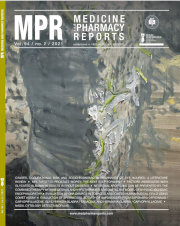Laparoscopic sleeve gastrectomy as a primary bariatric procedure: postoperative outcomes
DOI:
https://doi.org/10.15386/mpr-1762Keywords:
laparoscopic sleeve gastrectomy, weight loss, quality of life, weight gainAbstract
Background and aims. Laparoscopic sleeve gastrectomy is at present the most popular bariatric procedure due to its significant effect on weight loss, resolution of comorbidities and improvement in the quality of life. However, there are not many studies showing its medium and long term efficacy and safety in Eastern Europe. We aim to report the outcomes of laparoscopic sleeve gastrectomy as a primary bariatric procedure from a single surgical department.
Methods. This is a retrospective analysis of obese patients who underwent laparoscopic sleeve gastrectomy between 2009 - 2016 in our department. Outcomes were analyzed in terms of weight loss, comorbidity resolution and quality of life changes.
Results. A number of 70 patients were included in the study, with a mean age of 47.6 ± 9.8 years. Mean initial Body Mass Index was 47.4 ± 6.4 kg/m2. The mean percentage of excess weight loss during follow-up was 78.2% at 12 months, 80.2%, 76.7%, 74.7%, 72.8%, 73.3%, 74.1%, 67.2%, 64.07%, 69.7% at 24, 36, 48, 60, 72, 84, 96, 108 and 120 months, respectively. Weight regain occurred in 61 (87.1%) patients during the postoperative period. The mean weight regained was 8.1 ± 4.8 kg at 24 months postoperatively. Regarding the quality of life, 83% of patients declared an increase in self-esteem. Resolution of diabetes, arterial hypertension, and obstructive sleep apnea syndrome occurred in 80%, 42.5% and 70.1% of patients respectively.
Conclusions. Laparoscopic sleeve gastrectomy is an effective procedure, with good outcomes in the medium and long term, although a tendency for weight regain was noted after 2 years. Resolution of comorbidities is comparable with that reported in the literature, namely an improvement of the quality of life.
Downloads
Published
How to Cite
Issue
Section
License
The authors are required to transfer the copyright of the published paper to the journal. This is done by agreeing to sign the Copyright Assignment Form. Whenever the case, authors are also required to send permissions to reproduce material (such as illustrations) from the copyright holder.

The papers published in the journal are licensed under a Creative Commons Attribution-NonCommercial-NoDerivatives 4.0 International License.

